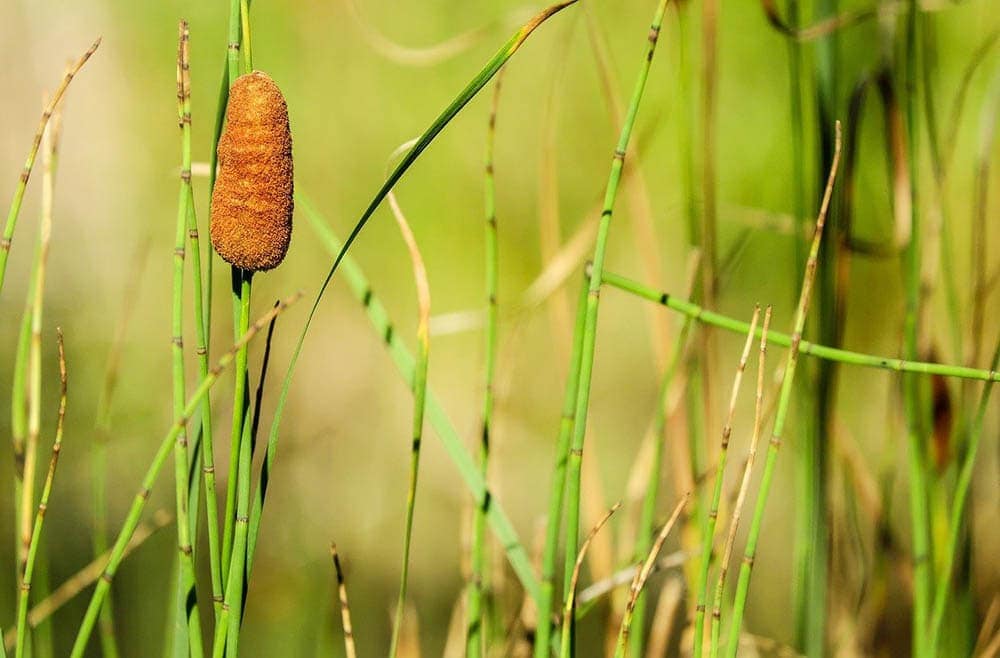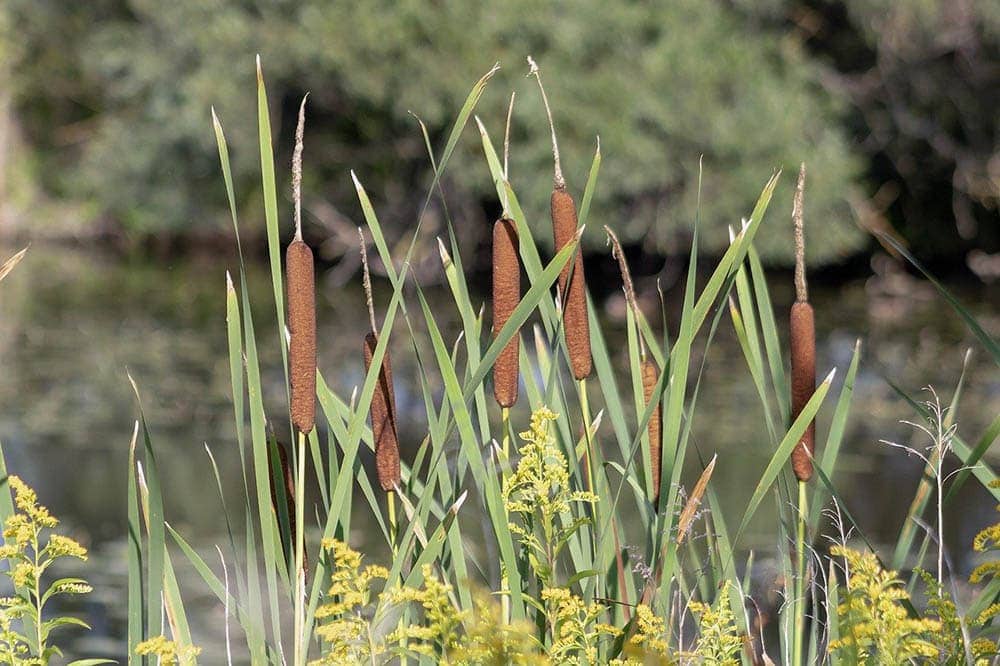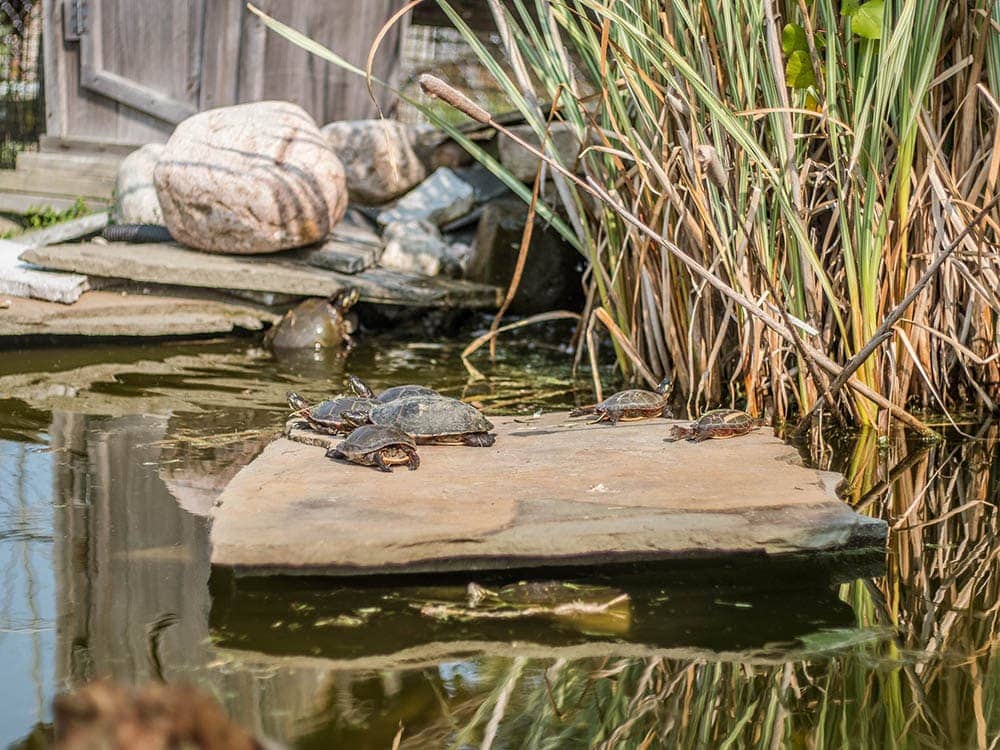One of the dreaded freshwater plants is the cattail. These are invasive plants that seemingly creep into ponds and rapidly grow to extreme lengths. Not only are these plants unsightly, but they can damage established ponds. The cattail plant is common in local rivers, streams, and other slow-moving bodies of water. They pose a risk to the aquatic life within the pond, and safe removal can be difficult.
If you are looking for an effective method to remove cattails from your pond without harming your fish, then this article will provide you with all the information you need to know!

Cattail Info & Growth
Cattails (Typha) are aquatic and marsh herbs with long, narrow leaves and deep roots. They can easily be identified by the brown tubular growing out from the stem. This is known as a catkin. Cattails grow rapidly and can overrun a pond in less than a year. The cattail removes large amounts of oxygen from the water which can put fish at risk of suffocation. In cases where growth is extreme, it is common for large ammonia spikes to occur due to the dead leaves melting in the water.
The cattail does have several benefits, but they usually do not apply to ponds. Ponds do not contain the same large amount of water as rivers or wetlands do, which means these invasive plants have a more negative effect on small bodies of water. They can negatively impact aquatic life and draw essential nutrients, oxygen, and kill off other species of plants. This can wreak havoc on a small pond ecosystem. The plant also blocks off oxygen from entering the water as its long leaves cover the surface and stop water movement.

Types of Cattails
Several different types of cattails are broken down into groups. Although these plants are within the same classification, each type has differences in appearance and growth. Identifying if you do indeed have cattail growing in your pond is the first step towards a successful removal. Cattail can look like other types of aquatic plants such as the Sweet Flag or Calamus. There is a look-alike called the Iris which is poisonous to both fish and humans.
- Narrowleaf cattail: This type of cattail is obligated to wetlands, which makes ponds the perfect place for them to grow. They are generally found in ponds with a high salinity content as they are naturally found in brackish water.
- Southern cattail: This type of cattail typically has more yellow leaves that are significantly narrower than other types of cattails.
- Dwarf cattail: This is a miniature version of the cattail species. It has thick stems branching out and grows smaller than the typical cattail plant. It is also commonly known as dwarf bulrush. The stems poke straight up, and the catkin is shorter.
- Common cattail: This is the typical version of the cattail plant. It has narrow leaves that fan out around the stem that holds the bur-reed. It is also the fastest-growing cattail.
- Hybrid cattail: This is a hybrid of the common broad-leaf cattail and the narrow-leaf cattail.
How Cattail Enters Ponds
Cattail can make their way into a pond in many ways. The most common way is through local wildlife birds. Birds that nest in the marsh of a river can ingest the seeds of the cattail plant. When these birds start flying over household areas, they may excrete waste that contains the undigested seed. This seed then makes its way into the pond and starts to develop.
Another common way cattail enters ponds is through commercial seeds. If you plan to plant various aquatic plant seeds in the pond, a few of them may be a form of cattail. This is commonly mixed in with imported seeds sold at pet stores.

The 3 Ways to Get Rid of Cattails
1. Non-herbicide management
Manual removal
This is typically for small populations of cattails. The cattail plant can be removed by hand. You will need to grip them as close to the base as possible. The pond should be drained till 40% of the water has been removed. This will also help you to see the bottom of the cattail plants better. The cattail should be gripped tightly at the base of the stem just above the roots and pulled till the rhizome and roots come out as well. If you do not remove the entire plant, the rhizome will grow a new shoot next spring. Make sure you wear thick gardening gloves during this method!

2. Chemical management
Hydrogen peroxide
One milliliter of hydrogen peroxide can be used per 3 gallons of water in the pond. Do not exceed this dosage as it’s harmful to fish if overdosed.
Algaecide
This targets algae, but higher doses can kill live aquatic plants. The chemical should be poured over the cattails.
Pond cleaners
This typically comes in powder form. They clear the pond of algae and can be used in higher doses to kill invasive aquatic plants. Ensure that the manufacturer has deemed it safe to use for fish even in high doses.
3. Herbicide management
These herbicides are commonly used by farmers for local waterways that have been overrun with marshy plants, but it works for ponds too. You will need to adjust the doses according to the number of gallons of water the pond holds. These have been deemed safe for fish and other species of plants.
Diquat (Reward)
It is quickly absorbed by invasive plants and kills them quickly. Follow the dosing instructions carefully.
Imazamox (Clearcast)
This is a slow-working herbicide that stops the growth of the plant within a few days. It moves through plant tissue to kill the plant from the inside.
Glyphosate (Rodeo)
This can kill off cattails growing above the waterline or in the substrate surrounding the pond. It is ineffective in water.
Imazapyr (Polaris)
The active ingredient inhibits the plant enzyme known as AHAs. It can be sprayed on post-submergent plants to kill them.

Removing Dead Cattail from Ponds
It is important to remove dead or dying cattails from the pond. Cattails will melt in the water and cause the water to foul. This can cause an immediate, yet deadly ammonia spike that will kill the fish and any other living organisms in the pond.
Use a pond net to capture the dead plants and use hand removal where possible. You can expect herbicides or chemicals to kill the cattails within a few days.
Important Precautions
Oxygen depletion
When you are using chemicals and herbicides in the water, it can cause the oxygen in the pond to diminish during treatment. You can help combat this by adding large oxygenators on each side of the pond.
Chemical residue
If you use herbicides and chemicals, they can leave residue in the water even after treatment is over. This can be seen as a foamy substance floating on the surface of the pond. Gradual water changes should be done to dilute the leftover treatments.

Invertebrates
Chemicals and herbicides are not safe for snails, crayfish, or shrimp. They are safe for fish, but not invertebrates. If your pond contains snails and other invertebrate creatures, you should put them in a bucket or second tank during treatment. Only add them back inside once you have done a water change and removed leftover treatments.
Disposal
The cattails should be disposed of in a plastic bag that is tightly sealed. They should be placed in a garbage bin and should never be introduced into the environment. They are an invasive species. In many states, fauna wildlife conservations state that cattails are invasive, and it is illegal to release parts of the plant into wetland areas because they will negatively impact the local fauna in the area.

Final Thoughts
Cattails may be annoying to see growing in your ponds, but there are many ways you can remove them and maintain any excess overgrowth. Before you begin treating the pond with an herbicide or harsh chemical, always check with an aquatic professional about the right dosage and any safety risks you should be made aware of.
We hope this article has helped you to find an effective method to remove cattails from your pond!
Read More: How to Get Rid of Pond Weeds
Featured Image Credit: Denny Müller, Unsplash
